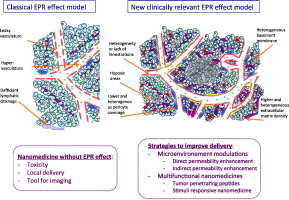当前位置:
X-MOL 学术
›
J. Control. Release
›
论文详情
Our official English website, www.x-mol.net, welcomes your
feedback! (Note: you will need to create a separate account there.)
To exploit the tumor microenvironment: Since the EPR effect fails in the clinic, what is the future of nanomedicine?
Journal of Controlled Release ( IF 10.5 ) Pub Date : 2016-11-25 02:27:54
F. Danhier
Journal of Controlled Release ( IF 10.5 ) Pub Date : 2016-11-25 02:27:54
F. Danhier

|
Tumor targeting by nanomedicine-based therapeutics has emerged as a promising approach to overcome the lack of specificity of conventional chemotherapeutic agents and to provide clinicians the ability to overcome shortcomings of current cancer treatment. The major underlying mechanism of the design of nanomedicines was the Enhanced Permeability and Retention (EPR) effect, considered as the “royal gate” in the drug delivery field. However, after the publication of thousands of research papers, the verdict has been handed down: the EPR effect works in rodents but not in humans! Thus the basic rationale of the design and development of nanomedicines in cancer therapy is failing making it necessary to stop claiming efficacy gains via the EPR effect, while tumor targeting cannot be proved in the clinic. It is probably time to dethrone the EPR effect and to ask the question: what is the future of nanomedicines without the EPR effect? The aim of this review is to provide a general overview on (i) the current state of the EPR effect, (ii) the future of nanomedicine and (iii) the strategies of modulation of the tumor microenvironment to improve the delivery of nanomedicine.
中文翻译:

开发肿瘤微环境:由于EPR效应在临床上无效,因此纳米药物的未来是什么?
以纳米药物为基础的疗法靶向肿瘤已成为一种有前途的方法,可以克服常规化疗药物缺乏特异性,并为临床医生提供克服当前癌症治疗方法缺点的能力。纳米药物设计的主要潜在机制是增强的渗透性和保留(EPR)效应,被认为是药物输送领域的“皇家大门”。但是,在发表了数千篇研究论文之后,判决就被宣告下来:EPR效应对啮齿动物有效,但对人类无效!因此,癌症治疗中纳米药物设计和开发的基本原理未能使它有必要停止通过EPR效应声称获得疗效,而在临床上无法证明靶向肿瘤。现在该是时候否决EPR效应了,并提出一个问题:没有EPR效应的纳米药物的未来前景如何?这篇综述的目的是对(i)EPR效应的当前状态,(ii)纳米医学的未来以及(iii)调节肿瘤微环境以改善纳米医学递送的策略提供总体概述。
更新日期:2016-11-25
中文翻译:

开发肿瘤微环境:由于EPR效应在临床上无效,因此纳米药物的未来是什么?
以纳米药物为基础的疗法靶向肿瘤已成为一种有前途的方法,可以克服常规化疗药物缺乏特异性,并为临床医生提供克服当前癌症治疗方法缺点的能力。纳米药物设计的主要潜在机制是增强的渗透性和保留(EPR)效应,被认为是药物输送领域的“皇家大门”。但是,在发表了数千篇研究论文之后,判决就被宣告下来:EPR效应对啮齿动物有效,但对人类无效!因此,癌症治疗中纳米药物设计和开发的基本原理未能使它有必要停止通过EPR效应声称获得疗效,而在临床上无法证明靶向肿瘤。现在该是时候否决EPR效应了,并提出一个问题:没有EPR效应的纳米药物的未来前景如何?这篇综述的目的是对(i)EPR效应的当前状态,(ii)纳米医学的未来以及(iii)调节肿瘤微环境以改善纳米医学递送的策略提供总体概述。































 京公网安备 11010802027423号
京公网安备 11010802027423号